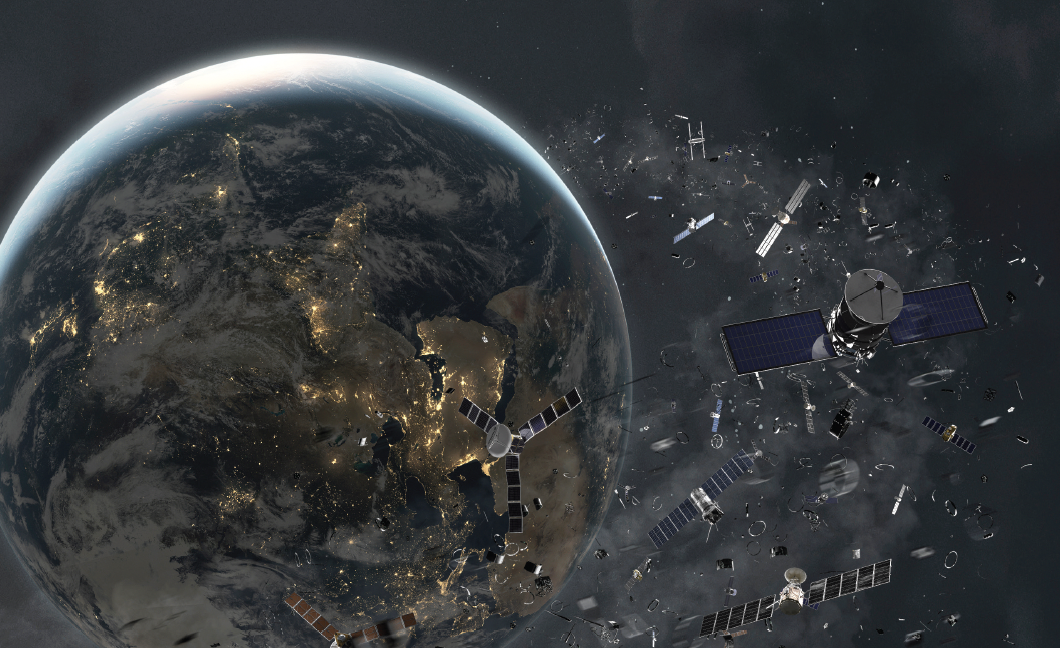Space debris is a growing concern for the industry, especially given the projected increase in the number of satellites that will be on-orbit by the close of this decade.

The risk of collisions in space is undisputable: only a few months ago, NASA’s Earth observation satellite, TIMED, had an uncomfortably close near miss (<20 meters, by some reports) with a derelict Russian satellite, Cosmos 2221. And with the expansion and launch of LEO mega constellations such as Starlink, OneWeb, Kuiper, Lightspeed and Guo Wang, the number of satellites on-orbit is clearly going to rocket.
Some analysts are forecasting that 2,800 satellites will be launched annually between 2023 and 2032. The growing density of satellites on-orbit increases the risk of collisions between a satellite and debris and this has a significant financial impact on operators as well as the wider space industry.
Without actions to address the risk that space debris poses, such will severely limit the potential for future satellite missions, compromising existing services, and, yes, eventually making space unusable. The need to mitigate the risk of collisions between satellites and space debris is well recognized — the implications of inaction are huge. What is less clear, however, are the most cost- effective strategies to tackle this growing problem.
Debris: The Visible +
Invisible Enemy
Space debris, or orbital debris, consists of defunct satellites, spent rocket stages, and fragments from disintegration, erosion, and collisions. Debris travels at such high speeds that, in the event of a collision, even small debris, no bigger than your thumbnail, can cause significant damage to satellites, resulting in loss of service.
To prevent this from occurring, operators use Space Situational Awareness (SSA) capabilities to determine where objects are and calculate where they’ll be located next. With this information, operators can identify whether there is a risk of collision and are able take avoidance action, if necessary.
However, not all pieces of debris capable of causing damage are tracked and monitored: small and opaque pieces of debris are hard to see, making them difficult to identify and track. In fact, only a relatively small proportion of all of the debris on-orbit is actually identifiable and trackable.
The European Space Agency (ESA) reports that around 35,610 debris objects are regularly tracked by Space Surveillance Networks but estimates are that there are well over 131 million space debris objects between 1 and 10 mm orbiting Earth.
NASA reports that the U.S. Space Force 18th Space Defence Squadron is currently tracking more than 45,000 objects in Earth orbit. There are estimates that more than 100 million pieces of debris are not currently being tracked. In many ways, these smaller pieces of debris are more dangerous than the larger pieces as they are, in effect, an invisible enemy, and extremely difficult to defend against impacts in space.
Cost
Implications
Space debris carries significant cost implications for the industry. In the event that debris collides with a satellite, causing damage and disrupting service, the financial repercussions for satellite operators are significant, both directly and indirectly. Not only is there potential loss of revenue from service disruptions and the potential breach of contractual obligations with customers, but outages can also lead to reputational damage which can, in turn, result in revenue loss. Service providers are faced with the challenge of swiftly restoring services and that could involve switching to another satellite or deploying a replacement satellite, both of which carry significant costs.
Additionally, maneuvering satellites to avoid a potential collision is also a costly task for operators. Time and effort must be put in to assess the risk, fuel is needed to power the manevuer which can shorten a satellite’s operational life span, and there may also be costly downtime while the avoidance manevuer is undertaken. Added to that, the growing risk of on-orbit collisions is also likely to increase insurance premiums for satellite operators which, of course, translates to higher operational costs.
The financial implications of the space debris issue extend beyond satellite operators to the wider global community. A collision could lead to loss of satellite functionality and, in addition, collisions in space would potentially generate a debris cloud, and that could also lead to loss of usage of certain orbital regimes. That would disrupt services, such as communications, navigation, weather forecasting, and Earth Observation (EO). Such disruptions have far-reaching consequences for industries like telecommunications, aviation, maritime, and agriculture. For consumers, this means interrupted connectivity as well as reduced or limited access to critical services.
Tackling
Debris
There are different approaches for tackling space debris. Essentially, there is a need to: prevent the creation of any further space debris from being created; identify and track debris already in existence; and develop effective
methods to remove existing debris. While debris mitigation technologies and strategies are necessary to keep satellites safe, and to ensure long-term space sustainability, they are costly and require significant investment. Therefore, it’s critical that effort and available resource is focused on the actions that are most cost effective.
NASA recently published a comprehensive report that examined the costs and benefits of different approaches to mitigating the risk of debris through the prevention of new debris creation, tracking debris and also debris removal.

The report, which considers more than ten different methods to reduce the risk of collisions between satellite and debris, is a follow on from a NASA report published last year that focused specifically on debris removal.
The most recent research was carried out by NASA’s Office of Technology, Policy and Strategy and modeled how the orbital environment will evolve over the next 30 years. The researchers also modeled the financial consequences that spacecraft operators incur as they assess their risks to close approaches, maneuver to avoid a potential collision, and experience mission ending collisions with untracked debris. According to the modeling, the global economic cost of space debris-related issues is well over $100 million in just the first year of the simulation.
Interestingly, the study found that debris remediation can provide just as much bang for the buck as tracking and mitigation — according to the report, the most effective form of remediation is just-in-time collision avoidance, where large debris is nudged away from possible collisions as needed, by use of technology such as ground- or space-based lasers or sounding rockets that release dust to increase drag on debris.
The report goes on to state that the most-effective remediation method is to remove centimeter-size debris with a laser system: “In the best cases, just- in-time collision avoidance and removal of centimetre-size debris may return benefits that are 300 and 100 times their costs, respectively.”

The study also found that rapidly deorbiting defunct spacecraft is another highly cost-effective strategy. The researcher’s analysis indicates that reducing deorbit timelines from a 25 year rule to a lower rule cost-effectively reduces risk to operators: “the benefits of moving to a 15-year rule are 20–750 times the costs and may produce up to $6 billion in net benefits during our timeframe of interest.”
According to the report, the more the timeline is reduced between end of mission and deorbiting, the more net benefits can be gained: “There are diminishing returns to be had from deorbiting more rapidly, however, the ratios are still favourable and net benefits continue to increase.” The researchers found that implementing a 0-year rule, where satellites were deorbited immediately at mission end, would result in nearly $9 bilion in net benefits.
While the industry isn’t likely to adopt a 0-year rule in the near future, it’s certainly a goal to strive to attain. It’s reassuring, however, that the industry is at least moving in the correct direction, given the Federal Communications Commission (FFC)’s move from a 25 year orbiting rule to 5 years for FCC licensed LEO satellites, in addition with ESA who has also adopted a 5 year rule for ESA LEO missions.
Final
Thoughts
As the space environment continues to evolve, it’s crucial that the industry invests in and prioritizes the most effective debris remediation and mitigation technologies. NASA’s report highlights how just-in-time collision avoidance and the rapid deorbiting of defunct spacecraft not only mitigate collision risks but also offer substantial economic benefits, potentially saving billions of dollars.
Reducing the risk posed by debris and ensuring the safety of space operations will require concerted efforts and significant resources, but the long-term benefits far outweigh the costs. By investing in the required technology and implementing the strategies outlined in the NASA report, as well as developing better SSA capabilities, we can protect current and future satellite missions, maintain essential services, and preserve the usability of space for generations to come.
www.space-data.org

Joe Chan
Author Joe Chan is the Chairman and Executive Director of the Space Data Association. He is the Director of Flight Dynamics at Intelsat where he oversees the FDS operation and engineering of more than 70 GEO satellites that Intelsat currently operates. Mr. Chan has been with Intelsat for 24 years. Prior to joining Intelsat he worked at Goddard Space Flight center on the TOPEX/POSEIDON and Mars Observer projects.

